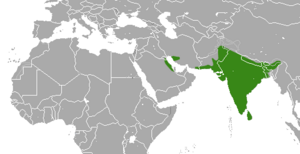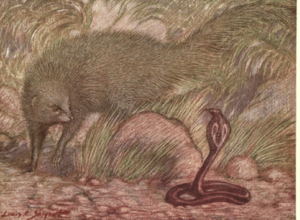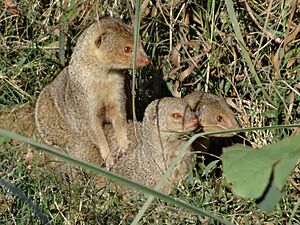Indian grey mongoose facts for kids
Quick facts for kids Indian grey mongoose |
|
|---|---|
 |
|
| Adult in Hyderabad | |
| Conservation status | |
| Scientific classification | |
| Genus: |
Urva
|
| Species: |
edwardsii
|
 |
|
| Indian grey mongoose range | |
| Synonyms | |
|
Ichneumon edwardsii |
|
The Indian grey mongoose (Urva edwardsii) is a type of mongoose. It lives in the Indian subcontinent and West Asia. This animal is quite common. Because of this, it is listed as "Least Concern" by the IUCN Red List. This means it is not currently in danger of disappearing.
These mongooses like to live in open forests, bushy areas, and farm fields. They often live near people. They make their homes in burrows, thick bushes, or under rocks. They can even hide in drains! Indian grey mongooses are brave and curious. But they are also careful and usually stay close to places where they can hide. They are great at climbing trees. They usually live alone or in pairs. They eat rodents, snakes, bird eggs, baby birds, lizards, and many different invertebrates (like insects). Sometimes, they even eat gharial eggs near the Chambal River. They can have babies all year round.
Contents
What Does an Indian Grey Mongoose Look Like?
The Indian grey mongoose has fur that is grey or iron-grey. Its fur is rougher and stiffer than other mongooses. It looks "grizzled" because each hair has rings of creamy-white and black. Its legs are brown and darker than its body. The fur around its nose and eyes is also brown, but with more of a rusty red color. Its tail is bushy. The tip of its tail might be pale yellow or white.
Their tails are about as long as their bodies. An Indian grey mongoose's body is usually about 36–45 cm (14-17 inches) long. Their tail is about 45 cm (17 inches) long. They weigh about 0.9-1.7 kg (2-4 lb). Male mongooses are much bigger than females. Indian grey mongooses are special because they can see four colors. Most other mammals cannot see as many colors.
Where Do Indian Grey Mongooses Live?
It is known that the Indian grey mongoose lives in countries like Saudi Arabia, Kuwait, Bahrain, Iran, Afghanistan, Pakistan, India, Nepal, Sri Lanka, and Bangladesh. In 2007, they were also found in Turkey and the United Arab Emirates. This showed that they live in even more places than people thought.
Even though they are common, we do not know everything about how they live in the wild. They can live in many different places. They prefer open areas like grasslands, rocky spots, and bushy areas. They also live in semi-deserts, farm fields, dry forests, and near human homes. Some people have seen them more often near towns in India, where they sometimes eat leftover food.
Mongoose Family Tree
The first scientific name given to this animal was Ichneumon edwardsii in 1817. Later, it was put into the group Herpestes. But now, all Asian mongooses are placed in the group Urva.
What Do Indian Grey Mongooses Eat and How Do They Behave?
The Indian grey mongoose eats many different things. Most of its food comes from live prey it hunts. It is an opportunistic hunter, meaning it eats what it can find. Its main foods are mice, rats, lizards, snakes, and beetles. They also eat ground birds, their eggs, grasshoppers, scorpions, centipedes, frogs, crabs, fish, and parts of plants like fruits, berries, and roots. Sometimes, they even hunt bigger animals like hares. They kill their prey by biting its neck or head.
This mongoose is famous for fighting venomous snakes. It usually wins by making the snake tired. It does this by making the snake strike many times, and the mongoose quickly dodges each attack. The mongoose also has some protection against snake venom. Its stiff, thick fur stands up when it is excited. Its skin is thick and loose. Also, it has special cells that make it resistant or immune to snake venom. When a mongoose fights scorpions, it does not try to avoid their sting. It just picks them up in any way it can.
When an Indian grey mongoose finds an egg, it usually holds the egg between its paws. Then, it bites a hole in the smaller end of the egg. Smaller mongooses sometimes open eggs by throwing them between their legs against a hard object. So, some people think that adult Indian grey mongooses might do this with very large eggs.
Reproduction and Life Cycle
Indian grey mongooses mate between March and October. They can have two to three litters of babies each year. The mother carries the babies for about 60 to 65 days. She usually gives birth to two to four young ones.
In the wild, an Indian grey mongoose usually lives for about seven years. If it lives in a zoo or is kept as a pet, it can live for up to 12 years.
Indian Grey Mongooses and People
People sometimes keep Indian grey mongooses as pets. They help keep homes free from rats and other pests.
The Indian grey mongoose is the official state animal of Chandigarh in India.
This animal is protected in India. However, there is still an illegal trade in their hair. Their hair is used to make paint brushes and shaving brushes. This illegal trade is one of the biggest dangers to the mongoose. In 2018, about 3,000 mongooses were killed to get 155 kg of their hair. This hair was later seized by authorities in Uttar Pradesh.
Names for the Mongoose
The Indian grey mongoose has different names in various languages:




